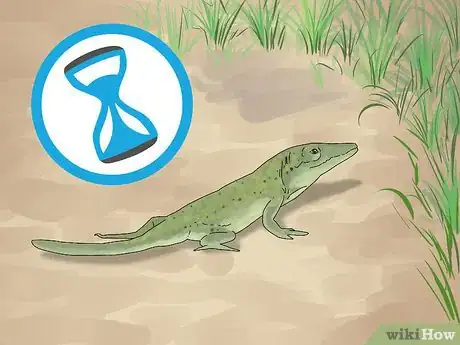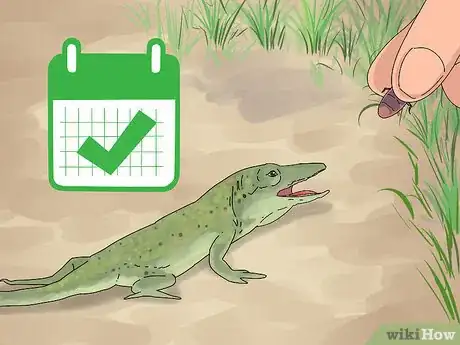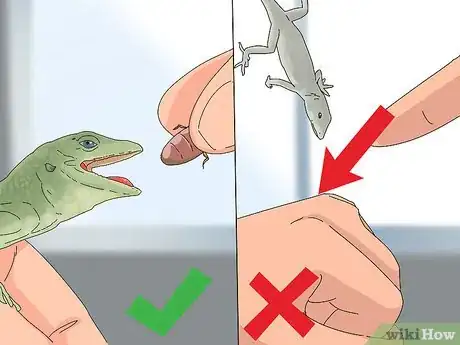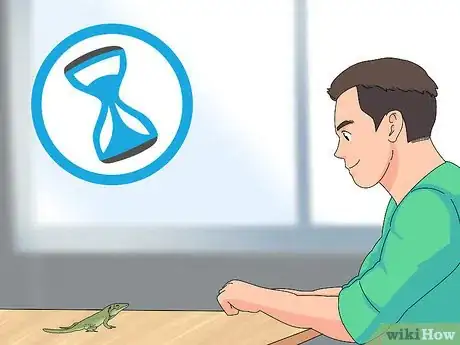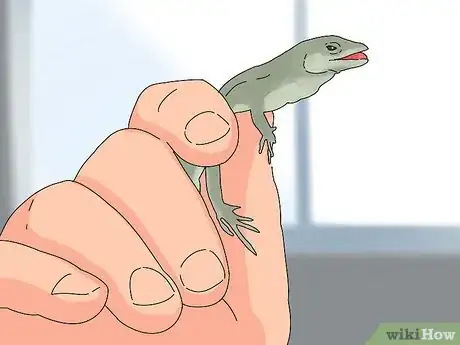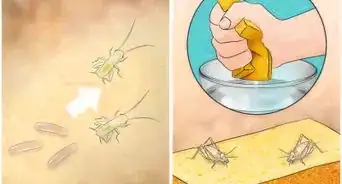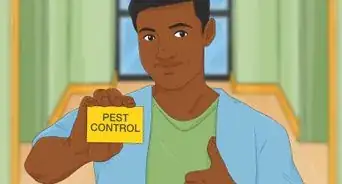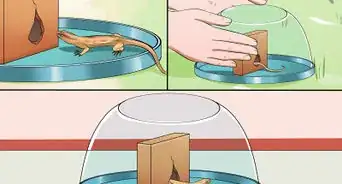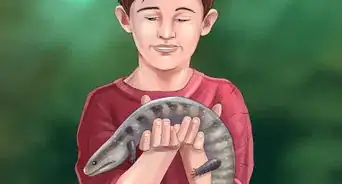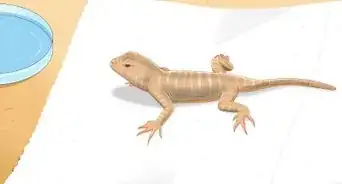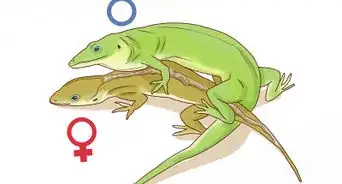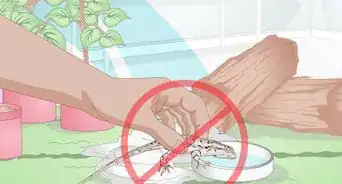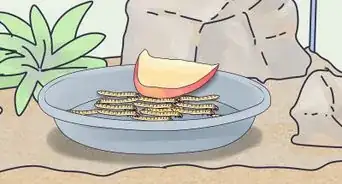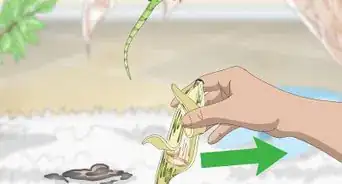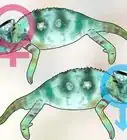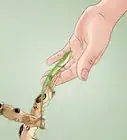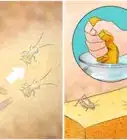This article was co-authored by Pippa Elliott, MRCVS. Dr. Elliott, BVMS, MRCVS is a veterinarian with over 30 years of experience in veterinary surgery and companion animal practice. She graduated from the University of Glasgow in 1987 with a degree in veterinary medicine and surgery. She has worked at the same animal clinic in her hometown for over 20 years.
wikiHow marks an article as reader-approved once it receives enough positive feedback. In this case, 89% of readers who voted found the article helpful, earning it our reader-approved status.
This article has been viewed 77,362 times.
Do you have a green anole lizard as a pet? By spending time with it, handling it delicately, and feeding it by hand, you may be able to make it a relatively tame pet. However, these delicate lizards are typically best as display pets that you can enjoy without touching.[1]
Steps
Getting a Green Anole Comfortable With You
-
1Give your lizard time to acclimate to its surroundings. When you get a new green anole, you should not try to handle it right away. Give it a few weeks to get used to its new surroundings before attempting to pick it up.[2]
- Allowing your lizard to get used to its surroundings will minimize the animal's stress and fear when you do try to pick it up.
- Provide hiding places within your lizard’s vivarium. This may help your lizard to manage its stress, which in turn may help it adjust to the new surroundings more quickly.
-
2Feed the lizard by hand. In order to get a green anole lizard used to you, begin feeding it by hand. Provide crickets, meal worms, or store-bought maggots and roaches to the lizard. You can even feed it grasshoppers or other wild insects that you catch yourself. This will show the lizard that you are not to be feared and that you will supply it with the food that it needs.[3]
- It may take some time for the lizard to take the food directly from your hands. Offer it, and if the lizard doesn't take it, release the food into your lizard's tank for it to eat on its own.
Advertisement -
3Interact with the lizard regularly. Spend time interacting with your green anole daily so it can get to know you. This will make it feel safer and more willing to be handled. After a period of normal interactions, such as feedings and cleaning its tank, your green anole should get used to you and allow you to touch it.[4]
- Try to pet the lizard gently on the head to check if it approaches you. Be warned, however, that the green anole may try to bite you when you first start interacting with it.
-
4Limit your expectations. Most green anoles can typically become comfortable enough with a person to be fed by hand or held. However, it is very rare that they can be taught to do tricks or follow commands. Getting it to sit on your hand or shoulder will be a great achievement.[5]
- Focus on increasing your lizard's general comfort with you, instead of trying to get it to follow your commands or to do tricks.
Handling Your Green Anole Correctly
-
1Wait for the lizard to approach you. Because green anoles are delicate lizards that can be injured by rough handling, it's important that you let it come to you instead of grabbing it up roughly. This can take some time, as the lizard may be fearful of you.[6]
- Make sure your anole is in a friendly mood when you try to pick it up. If you have a friendly, loving anole, then you can interact with it often. If not, leave it alone.
-
2Use gentle handling. If you want to get a firm hold on the lizard without it getting injured, put your thumb on its stomach and your pointer finger on its back. It will likely wiggle, but don't hold the lizard to firmly. A firm hold can injure the lizard greatly.[7]
- Because green anoles are delicate lizards, you should supervise children who handle them. Without supervision, a child could inadvertently injure your lizard.
-
3Watch for signs of comfort. The anole's eyes will begin to close if it is comfortable on your hand. If it is a male, its throat flap will fold back up and it's mouth will close. This is a sign that it's a good time for you to hold it without it biting you.
- A male anole that it puffing up its throat may be showing you that it thinks you are a threat. If your lizard is doing this, don't try to pick it up.[8]
-
4Wash your hands after handling. Lizards can carry a bacteria, viruses, or fungus on their skin, such as salmonella. This can be hazardous to humans, so it is important to wash your hands after handling them. Use antibacterial soap and hot water to make sure that your hands are thoroughly cleaned.[9]
- You can also wear gloves when handling a green anole to protect your hands and to keep germs off of you.
Warnings
- If a green anole tries to bite you, don't panic and just stay calm. If it does bite you, don't jerk away. This will likely result in breaking its jaw. Instead, wait for the lizard to release its grip on its own.⧼thumbs_response⧽
- Green anoles do best in the wild. Don't try to capture one in the wild and hold it as a pet, as this will decrease its lifespan dramatically.[10]⧼thumbs_response⧽
References
- ↑ http://www.reptilesmagazine.com/Care-Sheets/Green-Anole/
- ↑ http://www.reptilesmagazine.com/Care-Sheets/Green-Anole/
- ↑ http://www.reptilesmagazine.com/Care-Sheets/Green-Anole/
- ↑ http://www.reptilesmagazine.com/Care-Sheets/Green-Anole/
- ↑ http://www.reptilesmagazine.com/Care-Sheets/Green-Anole/
- ↑ http://www.reptilesmagazine.com/Care-Sheets/Green-Anole/
- ↑ http://www.reptilesmagazine.com/Care-Sheets/Green-Anole/
- ↑ http://www.nhptv.org/natureworks/greenanole.htm
- ↑ http://www.petsmart.com/learning-center/reptile-care/anole-care-guide/A0160.html
